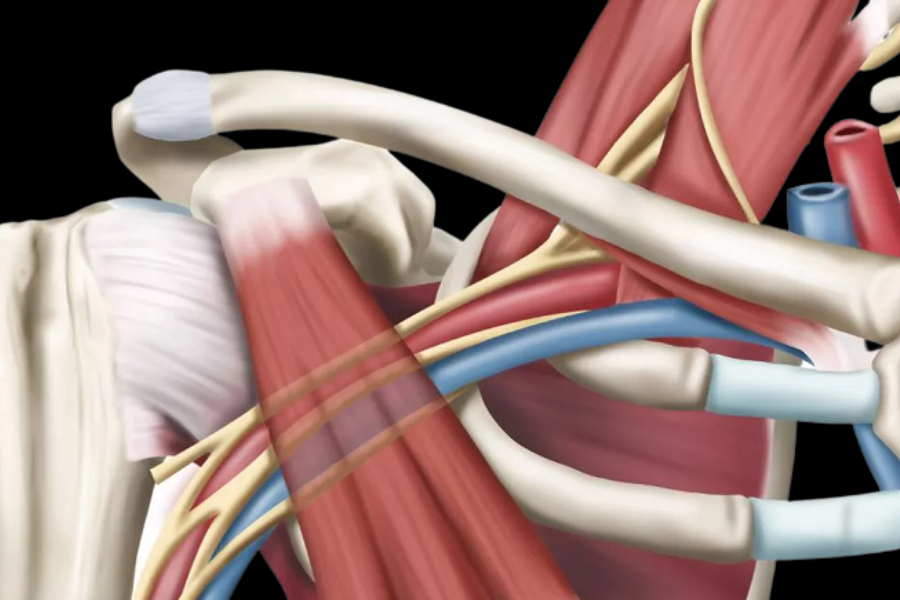If you’re dealing with Thoracic Outlet Syndrome (TOS), you know that it can be a painful and frustrating condition. TOS is a condition that occurs when nerves and blood vessels in the thoracic outlet (the space between the collarbone and the first rib) become compressed or irritated. This can cause a variety of symptoms, including pain, numbness, tingling, and weakness in the shoulder, arm, and hand.
Fortunately, Exercise Rehabilitation can be an effective treatment for TOS and is typically recommended as a first-line treatment. By working with an Exercise Physiologist, patients can develop a personalised exercise program that can help relieve their symptoms and improve their overall quality of life.

The Goal and Purpose Of Exercise Rehabilitation
The purpose of exercise rehabilitation for thoracic outlet syndrome is to alleviate symptoms and improve function by addressing the underlying musculoskeletal issues that contribute to the condition. TOS is a complex condition that can be caused by a variety of factors, including poor posture, muscle imbalances, and nerve compression. Exercise rehabilitation is designed to address these underlying factors with a goal of reducing pain, improve range of motion, and prevent further injury.
The length of time it takes to see improvements from exercise rehabilitation for TOS can vary depending on the severity of the condition and the individual’s overall health and fitness level.

By correcting imbalances and strengthening weak muscles, exercise rehabilitation can help reduce the pressure on the nerves and blood vessels in the thoracic outlet, which can alleviate symptoms such as pain, tingling, and numbness. In addition, exercise rehabilitation can improve overall function by improving range of motion and muscular endurance, which can help individuals perform daily activities with greater ease.
The length of time it takes to see improvements from exercise rehabilitation for TOS can vary depending on the severity of the condition and the individual’s overall health and fitness level. However, research has shown that exercise therapy can be effective for managing TOS symptoms in as little as six-twelve weeks. A randomised controlled trial published in the Journal of Electromyography and Kinesiology found that exercise therapy significantly improved pain and function in individuals with neurogenic TOS after just six weeks of treatment.
An Exercise Physiologist’s Exercise Techniques
To achieve the goals of reducing pain, improve range of motion, and prevent further injury, an Exercise Physiologist would begin with an appropriate initial testing process, before writing programs with exercises to:
- Improve range of motion: Exercise rehabilitation can help improve flexibility and range of motion in the neck, shoulder, and arm, which can reduce compression in the thoracic outlet and alleviate symptoms.
- Increase strength: Strengthening exercises can help build muscle in the shoulder and arm, which can help support the thoracic outlet and reduce compression.
- Improve posture: Poor posture can contribute to TOS symptoms by increasing pressure on the thoracic outlet. Posture exercises can help improve alignment and reduce pressure on the thoracic outlet.
- Reduce pain: Exercise rehabilitation can help reduce pain associated with TOS by improving circulation and reducing tension in the muscles surrounding the thoracic outlet.

It’s important to note that exercise rehabilitation is not a quick fix despite how fast symptoms can be relieved, and requires ongoing effort and commitment to see lasting results. In addition, exercise rehabilitation should be tailored to the individual’s specific needs and capabilities, and should be guided by a qualified exercise physiologist or physical therapist who has experience working with individuals with TOS.
Conclusion
In conclusion, Exercise Rehabilitation can be an effective treatment option for patients with Thoracic Outlet Syndrome. By working with an Exercise Physiologist, patients can develop a personalised exercise program that can help relieve their symptoms and improve their overall quality of life. Exercise techniques such as stretching and strengthening exercises can provide several benefits for patients, including pain relief, improved mobility, increased strength, and a better quality of life. If you are experiencing symptoms of TOS, it is recommended that you seek the advice of an Exercise Physiologist to determine the best course of treatment for your individual needs.






